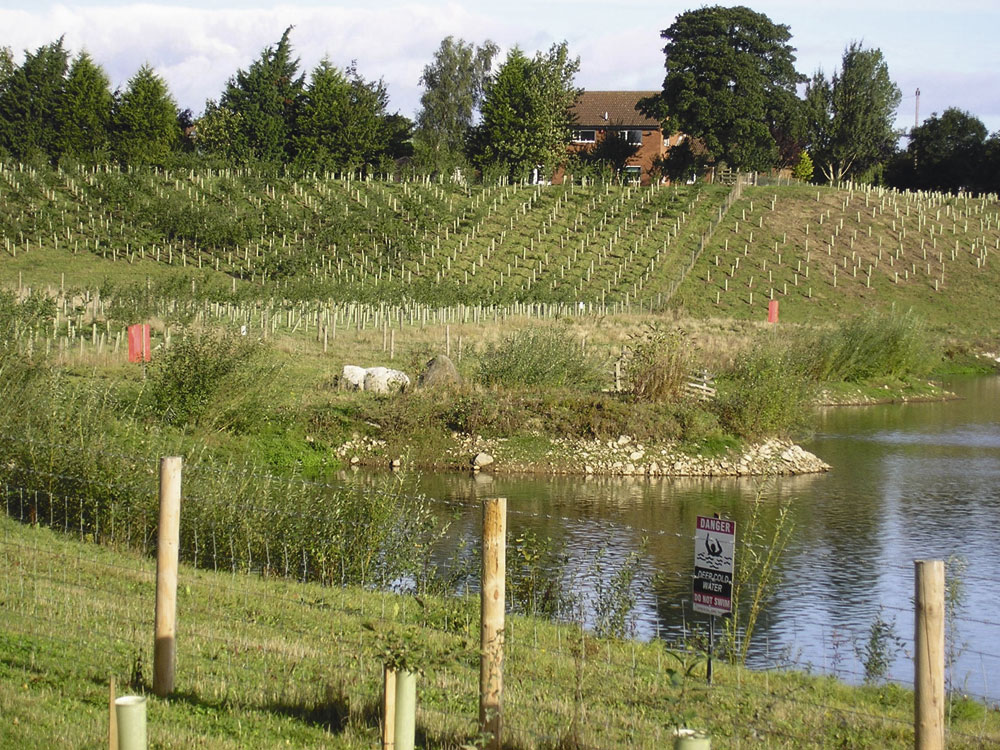Hollowbanks Quarry

Woodland, plants and lakes complete restoration
When visiting the countryside in areas underlain with valuable minerals, old quarries can often form part of the rural landscape. More recent quarries, however, are the subject of restoration conditions imposed by the local planning authority and carried out successfully and sensitively by companies such as Tarmac to create nature reserves, lakes and woodland areas.
Hollowbanks is a former sand and gravel quarry owned by Tarmac Ltd, located just east of the A1 at Brompton-on-Swale, near Catterick, North Yorkshire. The former quarry is some 50 acres in area following the extraction of 940,000 tonnes of sand and gravel between 1999 and 2003.
Mike Young, estates manager for Tarmac in the north-east of England, commented: ‘The restoration of Hollowbanks Quarry to a series of ponds with lake-edge planting, surrounding woodland and open grassland has resulted in the creation of a sensitive new habitat adjacent to the river Swale. This is a good example of Tarmac’s commitment to restoring sites for the benefit of the environment, wildlife and the local community, and the ongoing landscape maintenance managed by Steve Parlett of Bell Ingram will ensure that the site continues to thrive.’
The nature of quarrying means that the contour of the reinstated landform is often lowered considerably. Hollowbanks is typical of this process and the final landform has produced two large lakes and approximately 28 acres of mixed agricultural land and woodland.
The final mineral extraction was completed at Hollowbanks in 2003, and during the late summer of that year Tarmac moulded the contours of the land to produce the landform agreed with the local authority planning department. As the agreed contours were achieved restoration commenced, the first stage of which was soil reinstatement.
The first operation in any restoration scheme is to establish a suitable green cover. All areas were first sub-soiled to relieve the compaction caused by the vehicles used in soil reinstatement. With the top 400mm of soil loosened, and after picking stones off the surface, the land was cultivated and sown with grass seeds. Agricultural parcels were sown with a mix of predominantly rye grasses and clover, while the woodland blocks were sown with a lower-maintenance mixture of fescues, meadow grasses and bent.
Woodland areas were all ringed with stock-proof fencing to promote the grazing of adjoining agricultural blocks. Planting of the site was undertaken over two seasons in February 2004 and February 2005. In total, over 20,000 trees and shrubs have been planted at the site, with a current survival rate in excess of 95%. The species mix was chosen from a combination of trees and shrubs that were growing well in the area, as well as trees and shrubs that are known to do well on the vast majority of reinstated quarry sites in the North-East. The tree mix includes ash, oak, birch and cherry, with shrubs including alder, willow, hazel, blackthorn and hawthorn. All transplants were grown locally and all were planted in individual tree shelters to provide protection against the elements, rabbits and hares.
Rob Whamond of Lowther Forestry, the main contractor on site, said: ‘The establishment and development of 20,000 trees and shrubs on a reinstated quarry, with what is a very limited soil resource, has been a huge success. Without doubt the key is to choose good healthy stock from a local nursery and ensure as much as possible can be done to loosen any compaction before planting.
‘The foundations have been put in place for an attractive restoration scheme of well-formed lakes as well as a green cover across the site and the successful establishment of woodland blocks. The challenge now is to ensure that the newly completed work is effectively managed and the momentum of success is maintained.’
Work over the next three years will include:
- planting of aquatic plant species around the margins of the lakes to provide wildlife habitats and to soften the engineered appearance of the shores
- continued control of ragwort, thistle and dockens around the agricultural and woodland blocks
- replacement of any trees previously planted that have failed, thus preserving the planned species mix
- re-establishment of ‘rights of way’ crossing the site
- regular monitoring of the free-draining nature of the agricultural blocks of land and installation of any under-drainage that may be necessary
- continued improvement of the grass sward with more livestock on the agricultural blocks to ensure the land is both productive and self-managing
- monitoring the effect of wave action on the lakes with a view to reducing erosion of the banks and shores.
Steve Parlett of Bell Ingram, who currently have instructions on five similar former quarry sites, commented: ‘The key to any successful reclamation scheme, such as Hollowbanks, is continuity throughout – from the design of the scheme through to its implementation and ultimately the handing back to the landowner. Continuity of thought, ideas and management is essential for a positive outcome, as well as the ongoing partnerships between landowners, local planning authorities, mineral operators and all other stakeholders and interested parties.’
For further information on Hollowbanks Quarry or quarry reinstatement in general, contact Steve Parlett on tel: (01670) 790723; or email: steve.parlett@bellingram.co.uk
